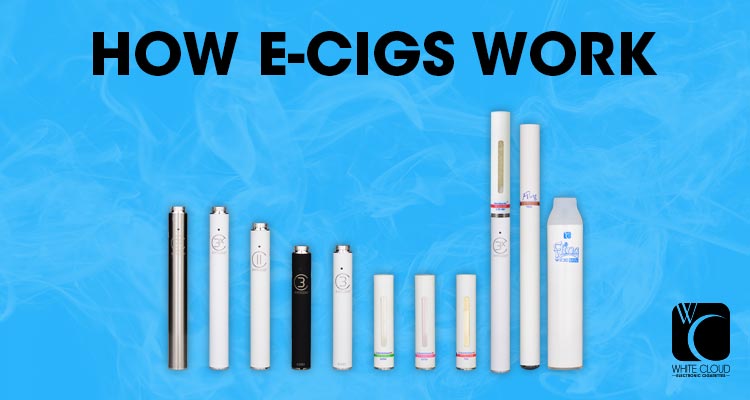Previous installments in our beginner’s guide to vaping series have touched on the history of electronic cigarettes and the evolving research and legislation surrounding them. Now that you’re familiar with the history of vaping and the terminology that goes along with it, it’s time to finally delve into the figurative nuts and bolts of how e cigs work.
What is E Cig Vapor?

As you’ll recall from our glossary of vape terms, all e cigs have three essential components: a battery, a heating element and the e liquid. E liquids contain a base of either propylene glycol or vegetable glycerin, or a mixture of the two, along with artificial flavorings and nicotine, while nicotine-free options are also very common. The basic premise to how e cigs work is a heating element “vaporizes” the e-liquid, which the user inhales and exhales to produce an effect similar to smoking.
Most e cigs are designed to closely mimic the sensation of smoking, which understandably makes people worry about the contents of e cig vapor. Unlike secondhand smoke, which we know is dangerous, studies have shown that e cig vapor is harmless to bystanders. That’s because e liquids, or e-juices, are composed of just a few ingredients rather than the hundreds of chemicals in cigarettes. Other studies have also found that e cig vapor dissipates in the air within seconds after being exhaled, rather than lingering in the air for hours and contributing to “third-hand” smoke given off by traditional cigarettes.
An Overview of Vaping Devices

When new vapers go shopping for their first e cig, they are often overwhelmed by the many different types of vaping devices, and how e cigs work, ranging from cig-a-likes and vape pens to regulated and unregulated mods, or advanced personal vaporizers (APVs). With so many options to choose from, where do you even begin? Well, if you’re a smoker looking to ease into vaping, then you may want to start with the cig-a-like.
A cig-a-like is just as the name implies: it is the original e-cigarette that closely resembles a traditional cigarette, both in function and aesthetics. Cig-a-likes are usually shaped just like a tobacco cigarette, but with a little more length to accommodate the battery, which is usually activated upon inhalation. The result is an experience much like smoking, except you don’t have to carry around a lighter or worry about containing your ashes (because no combustion = no ashes). Cig-a-likes are also compatible with prefilled e liquid cartridges, so all users have to worry about is keeping the cig-a-like charged and changing cartridges when the time comes, unless they go for disposable e cigs which don’t require any recharging or changing of cartridges – they are simply recycled when depleted. Cig-a-likes are indeed the best option for hassle-free vaping; however, seasoned vapers do tend to move onto “bigger and better” things.
Vape pens and APVs take vaping to a new level. These devices come with a lot more user customization and maintenance than the simple cig-a-like, so they are recommended for more experienced vapers; however, there is a wealth of information out there for those who want to skip the cig-a-like experience and get straight into customizing their vaping experiences.
Vape pens and APVs come in a range of shapes and sizes and are equipped with refillable tanks, which the user must fill with e-liquid. These devices also require extra maintenance, including cleaning and changing coils and wicks, as well as cleaning tanks after extended vaping or when changing flavors. Aside from aesthetics, user customization and maintenance, there is also one big notable difference that sets these devices apart from cig-a-likes: the battery.
Automatic vs. Manual E Cigarette Batteries

Some regular e cig users vape through life without knowing there are actually two types of e cig batteries that power how e cigs work. Most of the traditional cig-a-likes come equipped with automatic batteries, usually lithium polymer, that activate when the user takes a draw. Such devices are popular because they function similarly to tobacco cigarettes, and they often include safety features that prevent overheating.
Manual batteries, on the other hand, are button-operated. What this means is that in order to heat the e liquid to produce vapor, the user must press and hold a button to activate the battery – something many ex-smokers may find inconvenient while vaping and while carrying the device in their pockets. Some vapers have literally set their pants on fire due to these types of batteries accidentally activating in their pockets. So, while manual batteries give the user greater control over the temperature and electrical current, such freedom does come with risks.
Manual e-cigs are also usually powered by lithium-ion batteries, which are commonly used to power portable devices, such as power tools and electric vehicles. Lithium-ion batteries have a tendency to overheat and their packaging offers little room for the heat to escape, making them more dangerous than their lithium polymer counterparts; however, their low cost and availability make them a convenient option for powering e cigarettes. Your best bet when deciding to use a manual, lithium-ion powered e cigarette is to follow the do’s and don’ts for e cig battery safety.
Ohm’s Law and E Cigarettes
There is quite a bit of science that revolves around how e cigs work, and (unless you were a science geek in high school) you might not remember the term “Ohm’s Law”. Well, if you’re headstrong on jumping into advanced vaping, then it’s time for some fun with science. In fact, vaping has taught vapers so much about science, there is even a popular meme floating around the Internet, which states, “You learned more about electricity from vaping than you ever did in school.”
Ohm’s Law is all about the science of electricity, so it makes total sense that it is an important concept to understand when it comes to using electronic cigarettes. Now, we’re not saying you need a degree in physics to use or design an e-cig mod, but you should have a basic understanding of Ohm’s law when using advanced personal vaporizers.
All too often, inexperienced vapers tinker with their devices to create bigger vapor clouds without much knowledge of how Ohm’s Law works or just how dangerous it can be to essentially “play with fire”. One of these tinkering methods has become known as sub-Ohm vaping, or “sub-Ohming,” which simply means firing an atomizer at under 1 Ohm of resistance.
This strategy will produce some impressive vapor clouds, but failing to properly calculate the current can result in an electrical fire in your face. So, if you don’t want your 5 minutes of fame to be featured in a sensationalist news headline about exploding e cigs, then be sure to check out the extensive Ohm’s law vaping guide provided by our friends over at Vaping360.
So What’s in E Liquids?
Now that you’ve been given a crash course on how e cigs work, you may be wondering what ingredients go into e liquids and how they get their flavors. Well stay tuned because we’ll be telling you all about it in Part 4 of this Beginner’s Guide to Vaping series.






